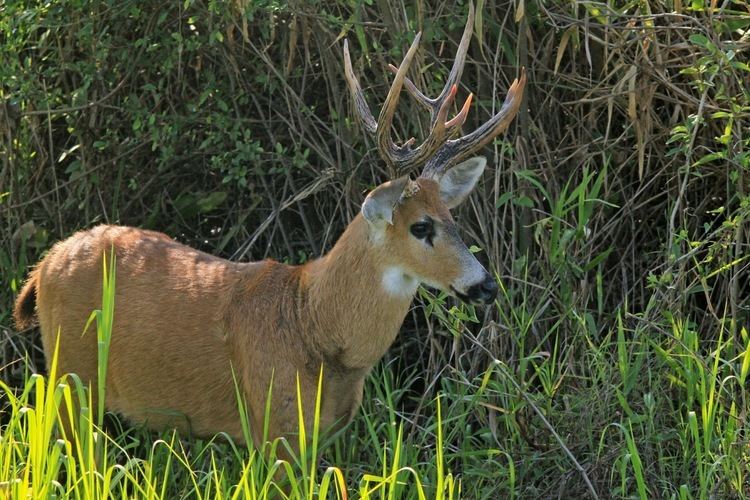Order Artiodactyla Higher classification Capreolinae | Phylum Chordata Family Cervidae Scientific name Mazama Rank Genus | |
Lower classifications | ||
Red brocket deer adapted for life in the rainforest
Brockets or brocket deer are the species of deer in the genus Mazama. They are medium to small in size, and are found in the Yucatán Peninsula, Central and South America, and the island of Trinidad. Most species are primarily found in forests. They are superficially similar to the African duikers and the Asian muntjacs, but unrelated. There are about ten species of brocket deer.
Contents
- Red brocket deer adapted for life in the rainforest
- Red brocket deer mazama americana in the yasuni
- Taxonomy
- Physical description and habitat
- Behavior
- Reproduction
- References
The genus name Mazama is derived from Nahuatl mazame, the plural of mazatl "deer".
Red brocket deer mazama americana in the yasuni
Taxonomy
The taxonomy among Mazama species has changed significantly in the last decades, and as recently as 1999 some authorities only recognized four species. These four "species", M. americana, M. gouazoubira, M. rufina and M. chunnyi included several distinct populations which subsequently were elevated to species status, resulting in a total of 9 different species being recognized in Mammal Species of the World in 2005. A 10th species, M. nemorivaga, has traditionally been included in M. gouazoubira, but this was shown to be mistaken in 2000. M. nemorivaga was not recognized as a separate species in Mammal Species of the World, but this was apparently an error. Yet another species, the fair brocket (M. tienhoveni) has recently been described from the lower Amazon basin. What may be an undescribed small species of brocket with a reddish pelage and blackish legs has been photographed in the lowlands of Manú National Park in Peru, and based on sight records may also occur in north-western Bolivia.

Molecular dating suggests that the family Cervidae originated and radiated in central Asia during the Late Miocene, and that Odocoileini dispersed to North America during the Miocene/Pliocene boundary, and underwent an adaptive radiation in South America after their Pliocene dispersal across the Isthmus of Panama. According to the systematic relationships and evolutionary history of Neotropical deer, at least eight ancestral forms of deer invaded South America during the late Pliocene (2.5–3 MYA), and members of the red brockets had an independent early explosive diversification soon after their ancestor arrived there, giving rise to a number of morphologically cryptic species. Deer endemic to the New World fall in two biogeographic lineages: the first one groups Odocoileus and Mazama americana is distributed in North, Central, and South America, whereas the second one is composed of South American species only and includes Mazama gouazoubira. This implies that the genus Mazama is not a valid taxon. Genetic analysis revealed high levels of molecular and cytogenetic divergence between groups of morphologically similar species of brockets (Mazama), and suggest a polyphyletic origin. In particular, Mazama americana showed a striking relationship with several sequences of Odocoileus in contrast to that expected, since this M. americana (now M. temama) haplotype, from a Mexican origin, was not associated with several Bolivian Mazama sequences analyzed. This could put forward that this genera is not monophyletic. On the other hand, these Bolivian Mazama formed a clade with Pudu puda and Ozotoceros bezoarticus. Likely, an Odocoileus virginianus sequence from the Central area of Colombia showed a more strong relationship with a North American O. heminonus sequence than with the other O. virginianus sequences of Colombian origin as well. This could be explained by various hypotheses. The first is the existence of common ancestral haplotypes between both species. Another is the reiterative hybridization among both Odocoileus species before the migration of O. virginianus from North America to South America.
Physical description and habitat
Depending on species, the brocket deer are small to medium-sized deer with stout bodies and large ears. The head-and-body length is 60–144 centimetres (24–57 in), the shoulder height is 35–80 centimetres (14–31 in) and they typically weigh 8–48 kilograms (18–106 lb), though exceptionally large M. americana have weighed as much as 65 kilograms (143 lb). When present, the antlers are small, simple spikes. The pelage varies from reddish, to brown to gray. Very roughly, the species can be divided into four groups based on size, color and habitat (but not necessarily matching their phylogeny):
Behavior
In addition to being nocturnal and their small size, Mazama are shy and thus rarely observed. They are found living alone or in mated pairs within their own small territory, the boundaries usually marked with urine, feces, or secretions from the eye glands. When approached by predators (primarily the Cougar and the Jaguar), being knowledgeable about their territory, they will hide in nearby vegetation. As herbivores, their diet consists of leaves, fruits, and shoots found within their territory.
Reproduction
Mated pairs who live together remain monogamous. Single male deer will usually mate with nearby females. When males compete for a mate, they fight by biting and stabbing with their short horns. Brocket species that live in tropical areas have no fixed mating season, but those in temperate areas have a distinct rutting period in the autumn.
The gestation period is roughly 200–220 days and females only bear one fawn at a time. The young stay with the mother, keeping concealed until large enough to accompany her. They are normally weaned at about six months of age and reach sexual maturity after a year.
